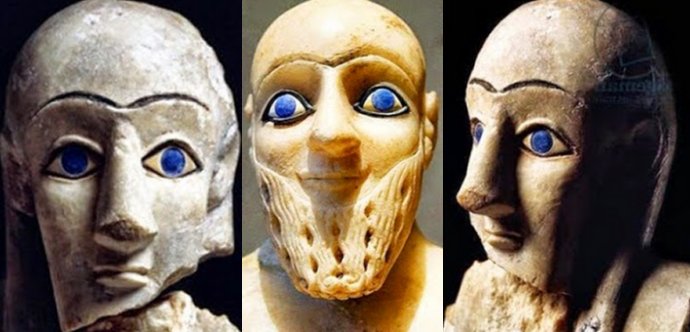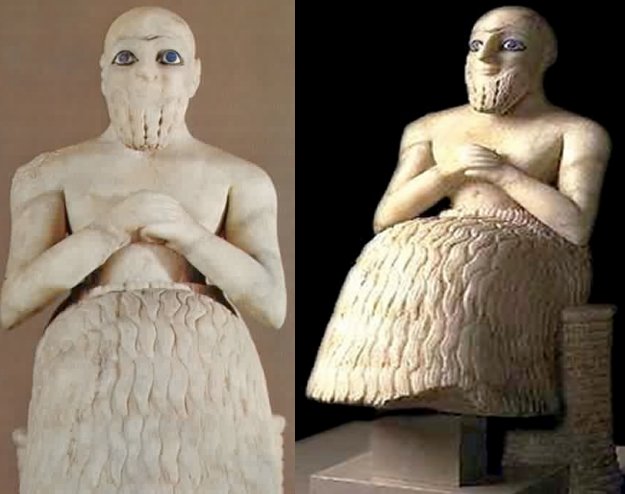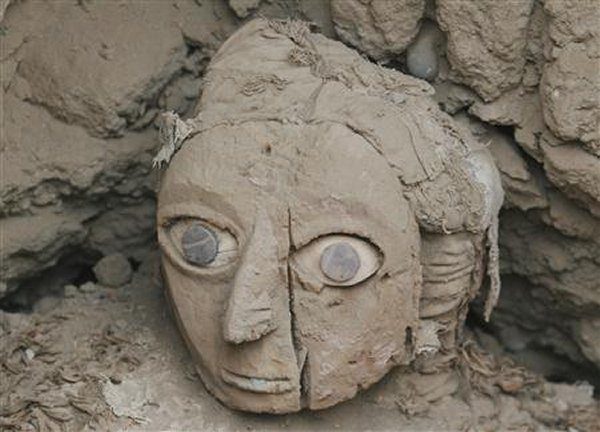Mysterious Sumerian Statues With Big Blue Eyes – A Sign From The Gods
Ellen Lloyd - Ancientpages.com - Sumerians made several ancient statues of beings who had huge and blue eyes. These ancient statues were then placed in the high temple on top of the ziggurat. It seems clear that the eye motif on these figures was very significant to our ancestors.
Why are the eyes usually looking up to something? What was the purpose or symbolism behind those big blue eyes?
What Did Sumerians Look Like?
Forensic archaeologist Jane Shuter studied several Sumerian burial grounds that contained skeletons. According to her, Sumerians were short and solid. They had thin lips, straight thin noses, and eyes that sloped downward. Shuter and other archaeologists suggest that Sumerians were dark-skinned, dark-eyed, and dark-haired. Sumerians also referred to themselves as “the dark-haired people.”
More than 5,000 years ago, the Sumerian culture emerged on a floodplain along the Tigris and Euphrates rivers in Mesopotamian, a region today known as southern Iraq. The word Mesopotamia comes from Greek words meaning "land between the rivers."
It was one of the most intriguing ancient civilizations that became famous for inventing cuneiform script.
The Sumerians built large cities and ziggurats with a terraced step pyramid and served as temples. Sumerians were skilled astronomers, they mastered medicine and created a sophisticated farming society. They were without a doubt one of the most advanced ancient civilizations.
Importance Of Religion In Sumerian Civilization
Ancient Sumer had a very complex pantheon of gods and goddesses, but four of these powerful figures played an important role because they were creators of everything. The Sumerian gods were depicted in human form. One of the most powerful and important gods was Enlil who arrived on Earth before humans were created.
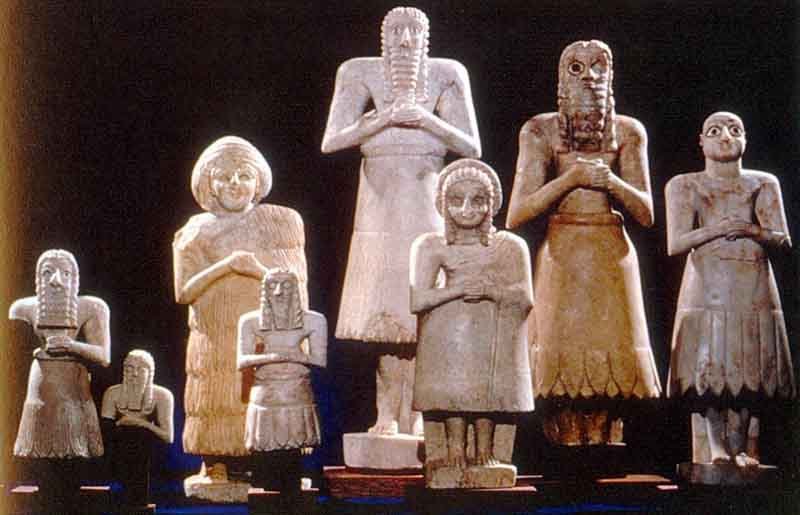
When you look at each statue, you can see that there seem to be some rules for making the sculpture and at the same time a lot of variation. Image credit: Study Blue
Blue Eyes Were A Sign From The Gods
Scientists at the University of Copenhagen in Denmark have tracked down a genetic mutation, which took place 6-10,000 years ago, and is the cause of the eye color of all blue-eyed humans alive on the planet today. It is possible that some Sumerians did have blue eyes, but if that was the case it is unlikely it was many people. Blue eyes were by no means common among Sumerians.
Like many other ancient civilizations, the Sumerians considered blue eyes to be a sign of gods. Some eyes are outlined and those without anything but white for the eyes have most likely lost the color that was inserted when the sculpture was new.
The ancient Sumerian statues with big blue eyes have symbolic meaning. Each of these statues is different. The faces and clothing are not alike. This means the statues were not created to represent one important individual but many different persons.
According to Irene J. Winter at the Columbia University, New York, “the enlarged, staring eyes of Mesopotamian votive statues have often been remarked upon as a characteristic stylistic feature, only occasionally with the proposition that their function must have been to denote attentiveness toward the presumed object of their gaze. Yet, it is known that these statues were placed in shrines either seated within their own chapels or standing in direct visual contact with the resident deity.“
Without access to contemporary texts, it is difficult to say with certainty what the Sumerians thought when they created the big blue-eyes statues. However, blue eyes were associated with the gods, and since many of the beings are looking up, we can distinguish a heaven and earth connection.
Similar ancient statues with blue eyes have been discovered in other parts of the world, for example, in Egypt, India, and South America. The ancient Wari mummy, known as the Lady of the Mask discovered in Peru, became famous for her enigmatic blue eyes.
Blue was a very significant color in ancient times, and having blue eyes was considered divine. Most likely, our ancestors believed that people with blue eyes stood closer to the gods.
Written by Ellen Lloyd – AncientPages.com
Copyright © AncientPages.com All rights reserved. This material may not be published, broadcast, rewritten or redistributed in whole or part without the express written permission of AncientPages.com
Expand for referencesMore From Ancient Pages
-
 Archaeologists Investigate The Mysterious Disappearance Of Human Skeletons In England And Wales During The 5th Century
Archaeology | Oct 16, 2024
Archaeologists Investigate The Mysterious Disappearance Of Human Skeletons In England And Wales During The 5th Century
Archaeology | Oct 16, 2024 -
 Dura-Europos Roman Shield Created With Ancient Painting Techniques On Wood
Archaeology | Nov 9, 2015
Dura-Europos Roman Shield Created With Ancient Painting Techniques On Wood
Archaeology | Nov 9, 2015 -
 Ancient Symbol Seed Of Life Contains Hidden Secrets Of The Seven Days Of Creation
Ancient Symbols | Oct 8, 2017
Ancient Symbol Seed Of Life Contains Hidden Secrets Of The Seven Days Of Creation
Ancient Symbols | Oct 8, 2017 -
 Ancient Wooden Toy Boat And Ancient Shoes That Dates Back To The Reign Of King St. Olav – Found
Archaeology | Mar 1, 2017
Ancient Wooden Toy Boat And Ancient Shoes That Dates Back To The Reign Of King St. Olav – Found
Archaeology | Mar 1, 2017 -
 Ji Gong: Legendary Ancient Monk Who Defended People Against Injustice
Chinese Mythology | Jan 31, 2016
Ji Gong: Legendary Ancient Monk Who Defended People Against Injustice
Chinese Mythology | Jan 31, 2016 -
 Alexander Nevsky: Grand Prince Of Novgorod, Skilled Fighter, Quick–Thinking Strategist Who Defeated Swedish And German Invaders
Featured Stories | Feb 22, 2019
Alexander Nevsky: Grand Prince Of Novgorod, Skilled Fighter, Quick–Thinking Strategist Who Defeated Swedish And German Invaders
Featured Stories | Feb 22, 2019 -
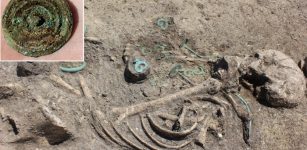 A Sensational Bronze Age Grave Of 20-Year-Old Elite Woman Found In Town Of Mány, Hungary
Archaeology | Aug 8, 2022
A Sensational Bronze Age Grave Of 20-Year-Old Elite Woman Found In Town Of Mány, Hungary
Archaeology | Aug 8, 2022 -
 Anne Askew: Woman Of Great Courage, Strong Beliefs And Principles Who Was Arrested For Heresy, Imprisoned, Tortured And Burnt At The Stake
Featured Stories | Feb 15, 2019
Anne Askew: Woman Of Great Courage, Strong Beliefs And Principles Who Was Arrested For Heresy, Imprisoned, Tortured And Burnt At The Stake
Featured Stories | Feb 15, 2019 -
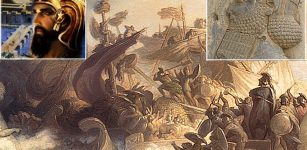 Achaemenid Empire Was The World’s Largest Ancient Empire
Featured Stories | May 24, 2021
Achaemenid Empire Was The World’s Largest Ancient Empire
Featured Stories | May 24, 2021 -
 How Is DNA Preserved In Archaeological Sediments For Thousands Of Years
Archaeology | Jan 3, 2022
How Is DNA Preserved In Archaeological Sediments For Thousands Of Years
Archaeology | Jan 3, 2022 -
 Who Built Massive Astronomically Oriented Buildings In The Most Ancient Times?
Civilizations | Nov 27, 2018
Who Built Massive Astronomically Oriented Buildings In The Most Ancient Times?
Civilizations | Nov 27, 2018 -
 Mesopotamians Worshipped An Unusual And Peculiar-Looking Creature – Archaeology And Sacred Texts Reveal – But What Was It?
Featured Stories | Dec 19, 2024
Mesopotamians Worshipped An Unusual And Peculiar-Looking Creature – Archaeology And Sacred Texts Reveal – But What Was It?
Featured Stories | Dec 19, 2024 -
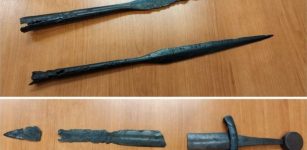 Swords And Spears Of The Yotvingians – A Long-Forgotten Ancient Warrior Culture Discovered In Poland
Archaeology | Jan 6, 2020
Swords And Spears Of The Yotvingians – A Long-Forgotten Ancient Warrior Culture Discovered In Poland
Archaeology | Jan 6, 2020 -
 Coronavirus: Advice From The Middle Ages For How To Cope With Self-Isolation
Featured Stories | Mar 29, 2020
Coronavirus: Advice From The Middle Ages For How To Cope With Self-Isolation
Featured Stories | Mar 29, 2020 -
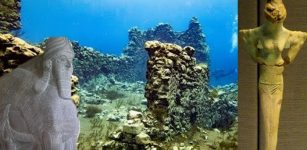 Searching For Dilmun: Underwater Ruins In The Persian Gulf Predate The Pharaohs And Sumer
Civilizations | Apr 24, 2023
Searching For Dilmun: Underwater Ruins In The Persian Gulf Predate The Pharaohs And Sumer
Civilizations | Apr 24, 2023 -
 Tribe Recalls Ancient Contact With An Extraterrestrial In The Amazon Jungle And A Strange Beam Of Light
Featured Stories | Jun 25, 2020
Tribe Recalls Ancient Contact With An Extraterrestrial In The Amazon Jungle And A Strange Beam Of Light
Featured Stories | Jun 25, 2020 -
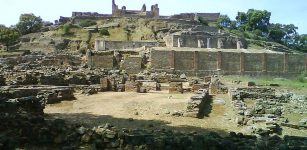 Immense Ancient Copper Mine Used By Romans Unearthed In Spain
Archaeology | Mar 20, 2017
Immense Ancient Copper Mine Used By Romans Unearthed In Spain
Archaeology | Mar 20, 2017 -
 Merneith: Mysterious Queen In The Land Of The Pharaohs Could Be Earliest Attested Female Ruler
Featured Stories | Mar 20, 2018
Merneith: Mysterious Queen In The Land Of The Pharaohs Could Be Earliest Attested Female Ruler
Featured Stories | Mar 20, 2018 -
 Mysterious Ancient Tully Monster Is So Weird It Cannot Be Classified
Fossils | Feb 22, 2017
Mysterious Ancient Tully Monster Is So Weird It Cannot Be Classified
Fossils | Feb 22, 2017 -
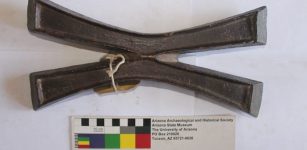 Copper Artifacts Reveal New Cultural Connections In Southern Africa
Archaeology | Mar 23, 2023
Copper Artifacts Reveal New Cultural Connections In Southern Africa
Archaeology | Mar 23, 2023

